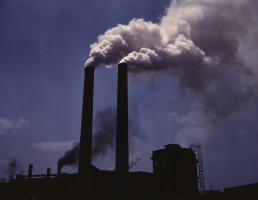Life Science News, November 4th 2013

Another quick rundown of the scientific news and breakthroughs of the last couple of days, from the carcinogenic miasma we inhale every single day to the biggest reptile of all time. Also, find out what happened the bees during the last days of the dinosaurs and why Thorium is creeping its way to prominence in the world of nuclear fission.
A Leading Cause of Cancer Could Be the Very Air We Breathe
Air pollution is one of the leading causes of cancer, according to data released by the The International Agency for Research on Cancer (IARC) this week. “Our conclusion is that this is a leading environmental cause of cancer deaths,” Dr. Christopher Wild, director of IARC, told the news briefing in Geneva. The IARC has already classified many chemicals and mixtures that can be components of air pollution, including diesel engine exhaust, solvents, metals and dusts. No real surprises there then!
Thorium Has Been Backed as a Much Safer Fuel Than Uranium
There has been a lot of buzz lately about the potential use of thorium as a fuel for nuclear reactors. Just this week, UN weapons inspector Hans Blix has called for serious consideration to be given to Thorium as a nuclear fuel. The advantages of Thorium over Uranium are many. Firstly, it is much safer. Thorium would not contribute to disasters like those that occurred at Fukushima or Chernobyl due to uncontrolled meltdowns. When Thorium is unstimulated, the reaction stops. Thorium is also three times more plentiful than Uranium according to current estimates. Lastly, and I’m guessing the reason closest to Mr Blix’s heart, Thorium cannot be used for nuclear weapons.
Greater Emphasis on Engineering and Computing required in Irish Universities, according to Forfás.
Ireland’s governmental advisory board on science, technology and innovation (Forfás) has said that a greater emphasis on computing and engineering is required at third level if the workforce is to meet the demand of future challenges. The body has predicted that 44,000 jobs in this sector could potentially arise in the next decade to add to the 68,000 current Information and Communications Technology (ICT) jobs. Forfás chief executive Martin Shanahan says that more women need to be encouraged to consider careers in the ICT sector as there is currently a significant male majority.
We all know sleeping is awesome and that it recharges our batteries but scientists have discovered a new and crucial reason why we slumber. Its not just to ‘recharge our batteries’ – the unconscious brain consumes around the same amount of energy as an alert one – but to clear our brains of toxins. Scientists noticed a difference in activity between sleeping brains and waking brains when they added a fluorescent dye to the cerebrospinal fluid of mice. During sleep, greater movement of the dye was recorded leading experts to believe that the brain was being ‘flushed’ through a network they dubbed the glymphatic system. For instance, beta-amyloid proteins – the ones which clog the brain in patients with Alzheimers – cleared out of the brain twice as fast in rodents that were awake. For those who study Alzheimer’s this is pivotal research. The condition has long been associated with an over production of the protein whereas suggestions are now pointing at the body’s lack of ability to clear it.
The Japanese Have Invented a Really Awesome Way to Harvest Solar Power
Researchers in Japan are pioneering a whole new way of harnessing the sun to create electricity. The technique involves a two-step process of which bears some resemblance to photosynthesis but provides an energy transfer that is far greater than current technologies (and photosynthesis itself which has about a 3% efficiency rate due to a) it only utilising certain parts of the light spectrum and b) diffusion for metabolic processes FYI) Nevertheless, photosynthesis in terms of converting photons to electrons is actually incredibly efficient due in part to this 2-step (photsystem 1/photosystem 2) process. About 99.99% efficient. In other words scientists are dead right to be emulating these systems. Photosystem 1 collects the photon and converts them to electrons, photosystem 2 shuttles the electrons to where they are needed. Scientists, in emulating this can potentially create ‘leaves’ of hundred of collectors which harvest electrons individually and then shuttle each electron directly to a reaction centre. Bare in mind, plants are only as efficient as they need to be. If science were to truly harness this techniques, 99% efficiency is possible in theory.
Argentinosaurus, the Biggest Dinosaur That Ever Lived, Could Not Run or Walk Up Hills
A team at the University of Manchester has digitally reconstructed the largest dinosaur currently on record. Working with scientists from Argentina they lazer scanned the 40-metre long Argentinasaurus skeleton. Then using an advanced computer modeling technique involving the equivalent of 30,000 desktop computers they recreated its walking and running movements and tested its locomotion ability for the very first time. What the researchers were up against were previous claims that the dinosaur was in fact too overgrown to move around. Using this massive computing power, they combined everything they could possibly predict about the animal and fed it into software designed by Dr. Bill Sellers of the University of Manchester. The results were that the dinosaur could not have moved faster than 2 meters per second and almost certainly could not have climbed any more than the most shallow of inclines. You can watch a video of the computer model simulating the colossal dino’s gait below.
Exercise Not Only Treats But Can Prevent Depression.
It may not be the right treatment for a depressed person to tell them to just go to the gym and forget it all, but there is increasing scientific data to suggest that exercise can play a massive part in the prevention of and recuperation from depression. Nonetheless, anyone who exercises regularly can attest to the immediate benefits to mood. Also, because of Depression’s increasing prevalence and impact on society more research is needed in identifying factors that may prevent depression. A recent review in the American Journal of Preventative Medicine examined whether physical activity is protective against the onset of depression. The results concluded that that post gym feeling is not just a fleeting rush of endorphins, but can in fact play a significant part in improving mental health overall.
Bees Underwent a Massive Extinction Around the Same Time As The Dinosaurs
All credit for this section goes to reddit user Old_Story (I had a piece written but this is way too awesome) For me personally this has shed a lot of light on the last days of the ‘terrible lizards.’
“This is tempting to read as a narrative about bees dying off and the dinosaurs following, but the more we understand about the meteor impact that ‘killed the dinosaurs’, so to speak, the more likely it seems that they were affected by that same event.
When I was young, paleontologists were positing the idea that the meteor impact threw huge amounts of dust in the atmosphere, and cooled the climate, leading to slow deaths from starvation and exposure as the ecosystem collapsed.
Newer models of the impact and its effects, however, suggest that it was an almost unbelievably catastrophic event. The meteor impacted to the east of modern mexico with a force equivalent to a billion of the atomic bombs dropped on Japan in WW2. In the area immediately under the impact, the superficial 3km(1.8 miles) of crust are simply vaporized upon impact. The impact site is temporarily hotter than the surface of the sun. All of the crust in a circular area 100km(62 miles) around the impact site, to a depth of 11km (7miles) was jettisoned outside of the atmosphere, though still within earth’s gravity. This would have dimmed the lights, sure, but the real damage occurs when that material comes back down.
As the ejecta re-entered the atmosphere, it ‘burned up’ on the way down, much the way small meteorites do. Ballistic models based on the calculated mass of ejecta re-entering the atmosphere suggest that an enormous amount of heat would be generated by this process, working out to about 10kW of energy per square meter. The sky glows red with heat, nearly the entirety of the earth’s surface cooks at 315oC (600oF), the vast majority of the planet’s forests spontaneously burst into flames. Every species of large surface animal roasts to death. Likely all the dinosaurs on the planet were dead in a matter of hours.
Extinction patterns mirror this pretty closely. The survivors were small mammals that could burrow beneath the ground to escape the heat, toads, snakes, crocodilians that could seek shelter in deep waters. A single class of birds survives: A waterbird that nested in holes in the banks of lakes. Oceanic extinctions follow as huge amounts of ash flow into the oceans and acidify them, the dust still in the atmosphere chills the planet for a millenium afterwards. On the bright side, this cleared the slate and allowed for colonization of the surface for our furry, rodent-like ancestors.
Bees dying shouldn’t really surprise us.”
Couldn’t really have said it better myself.
About the author: Conor Hughes works as a Marketing Executive at Life Science Recruitment







